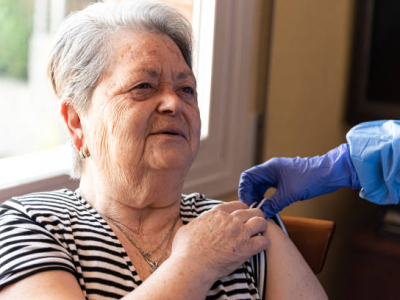Frozen breaded chicken tied to Salmonella outbreaks in 2 states, Canada
Health officials in Minnesota and Wisconsin are investigating a Salmonella outbreak linked to frozen breaded chicken products, and Canadian authorities are probing a similar outbreak also linked to the same type of product.
In the US outbreak, at least four illnesses have been reported, three in Wisconsin and one in Minnesota. All patients received frozen breaded chicken products at a Ruby's Pantry pop-up, a faith-based food pantry that distributes food at churches and other community sites.
Ruby's Pantry, however, in a Jun 1 news release, mentions six cases: "We've had three people in northern Wisconsin, one person in east-central Minnesota and two people in northwestern Minnesota who were affected by this and became ill."
Raw breaded chicken products have been linked to several previous outbreaks, because they may look fully cooked. Raw breaded chicken products must be cooked to an internal temperature of 165°F. The chicken products distributed to Ruby's Pantry patrons came with no cooking instructions or labels stating that the product was raw, according to a Jun 1 news release from the Minnesota Department of Health (MDH).
In its news release, Ruby's Pantry said it was not aware the chicken was uncooked. It now specifies proper cooking instructions in the release and elsewhere on its website.
Jun 1 MDH news release
Jun 1 Ruby's Pantry press release
Meanwhile, the Public Health Agency of Canada (PHAC) announced on Jun 2 that it, agriculture officials, and provincial health partners are investigating a Salmonella Enteritidis outbreak in eight provinces that has so far sickened 59 people. Ten people have been hospitalized, and no deaths have been reported. Illness onsets range from March to May.
Exposure to poultry, including frozen raw breaded chicken products, has been identified as the source of the illnesses. As part of the outbreak probe, the Canadian Food Inspection Agency has issued a food recall warning for No Name brand chicken burgers with a best-before date of Feb 6, 2019. The product was distributed nationally.
Several people reported eating No Name chicken burgers before they got sick, and a food sample has tested positive for Salmonella Enteritidis with a genetic fingerprint that matches isolates from patients.
Jun 2 PHAC press release
GAO finds states' preparedness funds from HHS have dropped 30%
The amount of money given to states by the US Department of Health and Human Services (HHS) for infectious disease, bioterrorism, and other public health preparedness has fallen almost 30%—from about $1.4 billion per year to about $1 billion per year—since 2003, when it was at its peak, the Government Accountability Office (GAO) said in a recent report.
GAO investigators noted that, from 2002 through 2017, HHS awarded about $3 billion to states and others to respond to specific disease threats, such as Zika, Ebola, and H1N1 pandemic influenza. HHS awarded an additional $18 billion for general public health preparedness activities. Their assessment of three programs found that most responder protection and coordination efforts met goals, while efforts in other areas were less consistent.
HHS directs three key preparedness and capacity-building programs—Epidemiology and Laboratory Capacity for Infectious Diseases (ELC), the Hospital Preparedness Program (HPP), and Public Health Emergency Preparedness (PHEP). These three programs awarded about $21.2 billion to states and other jurisdictions during the study period to carry out public health preparedness and response efforts related to infectious diseases, natural disasters, and terrorist events. Breakdown by program was $11.4 billion for PHEP, $5.6 billion for HPP, and $1.5 billion for ELC.
As the budget for states' preparedness efforts dropped from $1.4 billion to $1 billion from 2003 to 2017, HPP award amounts declined 54%, while PHEP grants dipped about 33% from 2002 to 2017. Annual appropriations through ELC, in contrast, doubled, from about $100 million to about $200 million.
GAO experts also looked at the performance of awardees based on 20 measures in four areas that directly relate to infectious disease preparedness capacity—electronic lab reporting, epidemiology capacity, laboratory capacity, and responder protection. They found that most awardees met all 9 measures for responder protection, 5 of 6 measures were met for lab capacity, 1 of 2 measures were met for electronic lab reporting, and only 1 of 3 measures was met for epidemiology capacity.
May 24 GAO report
Large US VAERS study finds DTaP vaccine safe
The switch from whole-cell pertussis vaccines to diphtheria-tetanus-acellular pertussis (DTaP) vaccines in the 1990s, which sacrificed a degree of efficacy for better safety, has paid off safety-wise, according to a study today in Pediatrics.
Researchers with the US Centers for Disease Control and Prevention, Food and Drug Administration, and elsewhere combed through data reported to the Vaccine Adverse Event Reporting System (VAERS) from Jan 1, 1991, through Dec 31, 2016. In that time VAERS received 50,157 reports on 50,157 events after DTaP vaccinations, of which 43,984 (87.7%) of them reported concomitant administration of other vaccines and 5,627 (11.2%) were serious.
The most common adverse event was injection-site redness (24.3%), fever (19.8%), injection-site swelling (15.0%), and other skin reddening (11.2%). The authors conclude, "No new or unexpected adverse events were detected. The observed disproportionate reporting for some nonserious vaccination errors calls for better education of vaccine providers."
In a related commentary, Flor M. Munoz, MD, of Baylor College of Medicine, writes, "Shortly after the introduction of acellular vaccines, the resurgence of pertussis in the United States raised concerns on the efficacy of DTaP, which has now been associated with a shorter duration of protection, leaving older children, adolescents, and adults unprotected. Therefore, pertussis control in the United States today requires the administration of booster doses of acellular vaccines in adolescents, adults, and pregnant women.
"There is an imperative need to develop more immunogenic pertussis vaccines that are also safe."
Jun 4 Pediatrics study
Jun 4 Pediatrics commentary
Incidence of Lyme-related bullseye rash increasing in Canada
From 2005 to 2014, more people were diagnosed as having Lyme disease (LD) in Ontario and displayed the telltale "bullseye" rash (erythema migrans, or EM), according to a new study led by Public Health Ontario published in PLoS One.
This is the first study tracking Lyme trends in Ontario, using data from 36 health units reporting to the web-based integrated Public Health Information System (iPHIS). During the 9years included in the study, 1,252 cases of LD were reported in Ontario, with annual case counts increasing fivefold from 2009 to 2014. Men and women accounted for cases equally, with the most affected age-group being those age 50 to 74 years.
"In 14.2% of cases, EM was the only symptom reported. Other clinical manifestations among all cases were as follows: 74.8% reported flu-like symptoms, 41.9% reported arthritic symptoms, 40.9% reported neurologic symptoms, and 5.7% reported cardiac manifestations," the authors wrote.
Incidence of EM rose with incidence of LD, the authors said. But the authors also explained that rashes were included as symptoms with or without a physician's diagnosis, which could have led to an over-estimation of EM.
"Despite possible misclassification of the three clinical stages of LD, we were able to elucidate trends. Incidence rates for the three clinical stages of LD increased over time, with the relative proportion of early to late disseminated disease varying spatially across Ontario," the authors concluded.
Jun 1 PLoS One study










